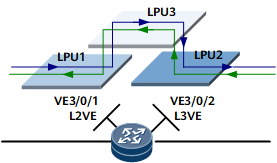L2VPN Accessing L3VPN Fundamentals
Basic Concepts
Virtual Ethernet (VE) interface
A VE interface has the common features of an Ethernet interface, and supports services such as maximum transmission unit (MTU) and QoS.
Layer 2 Virtual Ethernet (L2VE) interface
An L2VE interface supports VPWS and VPLS services.
Layer 3 Virtual Ethernet (L3VE) interface
An L3VE interface supports the termination of IP services or the access to L3VPNs. An L3VE interface also supports sub-interfaces.
VE-Group
As a connector of L2VE and L3VE interfaces, a VE-Group provides a type of virtual connection to associate L2VE interfaces with L3VE interfaces by using the same group ID.
One VE-Group corresponds to one L2VPN accessing L3VPN service. By creating multiple VE-Groups with VE interfaces bound to different L2VPNs and L3VPNs, you can implement multiple L2VPN accessing L3VPN services.
Implementation
On the network shown in Figure 1, L2VE and L3VE interfaces are bound by means of a VE-Group. L2VPN accessing L3VPN is implemented through the loopback between the L2VE and L3VE interfaces of the same VE-Group. Logically, the principle of the loopback between the L2VE and L3VE interfaces is similar to that of connecting two physical interfaces through fibers. One of the interfaces is bound to an L2VPN, and the other is bound to an L3VPN.
A VE-Group is associated with a tag. By setting up different VE-Groups and bind them to different L2VPNs and L3VPNs, you can configure multiple L2VPN accessing L3VPN services.
